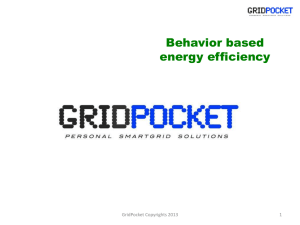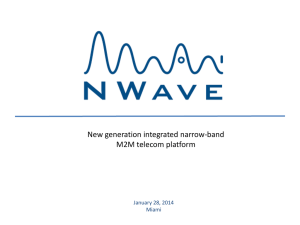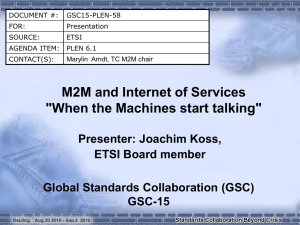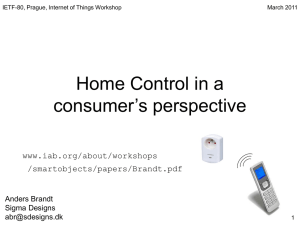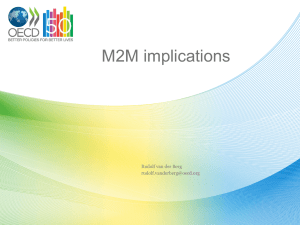PowerPoint ** - Wireless Internet Research & Engineering Laboratory
advertisement
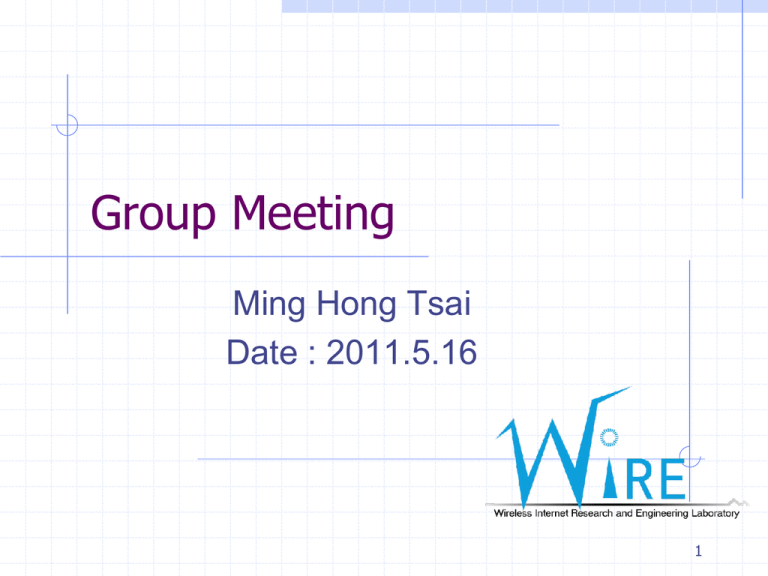
Group Meeting Ming Hong Tsai Date : 2011.5.16 1 Communication Magazine Vol. 49 Issue 4 2 Toward Ubiquitous Massive Accesses in 3GPP Machine-toMachine Communications 3 AIR Interface Considerations Physical Layer Considerations Random Access Channel Congestions 3GPP TSG RAN WG2 Meeting 71 R2-104662 Backoff-Based Scheme Access Class Barring (ACB) Based Scheme 3GPP TSG RAN WG2 Meeting 68bis R2-100182 Separating RACH Resources Dynamic Allocation of RACH Resources Energy and Complexity Considerations Energy consumption Proposed Transmission algorithm 4 Radio Resource Allocation with QoS Guarantees Enormously Diverse QoS Requirements Small Data and Massive Transmissions Proposed Grouping-Based Radio Resource Management 5 Home M2M Networks: Architectures, Standards, and QoS Improvement 6 PROPOSED ARCHITECTURE FOR HOME M2M NETWORKS Physical layer and MAC layer M2M communication M2M communication M2M communication M2M communication in body areas in personal areas (Zigbee) in local areas (WiFi) via cognitive gateway 7 STANDARDS FOR DEVICE AND RESOURCE SHARING IN HOME M2M NETWORKS Three major standards have been defined for facilitating the application layer multimedia discovering, searching, and sharing in home M2M networks UPnP (Universal Plug-and-Play) and its QoS Architecture DLNA (Digital Living Network Alliance) and its QoS Architecture Understanding Universal Plug and Play: A White Paper, June 2000 DLNA Overview and Vision Whitepaper, 2006 IGRS (Intelligent Grouping and Resource Sharing) and its QoS Architecture Information Device Intelligent Grouping and Resource Sharing QoS Specification for Wireless UWB networks (draft), 2008 8 QoS IMPROVEMENT IN HOME M2M COMMUNICATIONS Machine Model Resilient Non-Resilient Proposed A cross-layer joint design 9 GRS: The Green, Reliability, and Security of Emerging Machine to Machine Communications 10 OVERVIEW OF M2M COMMUNICATIONS ARCHITECTURE AND GRS REQUIREMENTS M2M domain Network domain Application domain 11 GRS IN M2M COMMUNICATIONS Energy efficiency Communication dominates energy consumption, and energy efficiency can be increased by wisely adjusting transmission power (to the minimal necessary level), and carefully applying algorithmic and distributed computing techniques to design efficient communication protocols (e.g., routing protocols[5]). Activity scheduling scheme “Localized Sensor Area Coverage With Low Communication Overhead,” IEEE Trans. 12 GRS IN M2M COMMUNICATIONS Reliabilty In sensing and processing a single M2M node may not be sufficient to accurately sense and process monitoring data. Local vote decision fusion (LVDF) algorithm In transmission Consider that there are n total positive monitoring data on the same event in the M2M domain, and the M2M GW will report the decision to the BS only if it can collect more than k distinct monitoring data packets. Spatial redundancy technology “Local Vote Decision Fusion for Target Detection in Wireless Sensor Networks,” IEEE Trans. “Spread: Improving Network Security by Multipath Routing in Mobile Ad Hoc Networks,” Wireless Networks At the BS In general, there is only one server activated to process these data packets for energy(power) saving purposes. However, when the number of arrival packets dramatically increases, especially during peak times, the single server cannot deal with the challenging situation, and reliability and QoS will degrade. Redundancy technologies How to balance greenness and reliability in M2M communications needs further exploration. 13 GRS IN M2M COMMUNICATIONS Security CIA, Non-repudiation, Access control, Availability, Privacy Efficiently detecting the node compromise attack is very challenging in the M2M domain. Early detecting node compromise in M2M Domain “CAT: Building Couples to Early Detect Node Compromise Attack in Wireless Sensor Networks,” Proc. IEEE GLOBECOM, To preserve energy, some M2M nodes switch to sleep mode. Then they could be compromised by an attacker without being detected. Later, these compromised nodes can inject false data and send them to the application domain, causing not only high-level erroneous decisions in an M2M application, but also energy wasted in multihop en route nodes. Bandwidth efficient cooperative authentication (BECAN) to filter false reports in M2M communications “SAGE: A Strong Privacy-Preserving Scheme against Global Eavesdropping for eHealth Systems,” IEEE JSAC, 14 Machine-to-Machine Communications for Home Energy Management System in Smart Grid 15 Open Research Issues Standardization Traffic Characterization Protocol Re-design Spectrum Management Optimal Network Design Home Energy Management System (HEMS) 16 M2M: From Mobil to Embedded Internet 17 The Vision of Internet of Things There are three essential components to this “Internet of Things” vision. A continuum of devices from low-cost/lowpower to compute-rich/high-performance Ultra scalable connectivity Cloud-based mass device management and services 18 The Essential Elements of M2M Solutions Security “security-on-chip” “zero-touch” manageability and information overload Large-scale surveillance networks Optimum distribution of device and cloud intelligence 19 M2M Connectivity and Network Architectures 20 Key Features for Air Interface Optimizations DRAFT-T31-127-R020-v01 3GPP TS 22.368 v10.1.0 21 Addressing Extremely Large Number of Devices Group Control Time-Controlled Traffic Time-Tolerant Traffic One-Way Data Traffic Extremely Low Latency Infrequent Traffic 22 M2M Usage Models 23 Toward Intelligent Machineto-Machine Communications in Smart Grid 24 Considered Architecture for SG Communication Neighborhood Area Network (NAN) Building Area Network (BAN) Home Area Network (HAN) 25 Toward effective SG communication SG communication depends on two important requirements, communication latency and large volume of messages IEEE IEEE IEEE IEEE 802.15.3a (UWB) 802.11 (WiFi) 802.15.1 (Bluetooth) 802.15.4 (Zigbee) 26 Envisioned Improvement to HAN Communications Based on Zigbee In a conventional HAN, if the M2M devices always attempt to send their periodic messages to the HAN GW, the HAN GW is expected to receive a relatively high number of messages. proposed Intelligent system based on Zigbee 27


